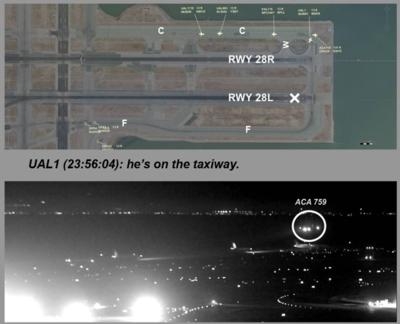Wed, Aug 09, 2017
Ground Surveillance System Could Prevent Aircraft From Landing On Taxiways
In 2011, the NTSB made a recommendation to the FAA to upgrade ground radar systems that would warn controllers when an airplane is lined up to land in the wrong place ... as happened recently in San Francisco when an Air Canada A320 nearly landed on a taxiway where four aircraft were waiting to take off.

At the time, the FAA disagreed with the recommendation according to government records, without even studying whether the solution was feasible.
Now, Bloomberg Technology reports that since the incident at KSFO July 7, the FAA has announced that over the past year, it has begun taking action on that safety recommendation, and testing on the system could begin in a few months. "We believe recent technological advances may now enable us to modify our ground surveillance systems to detect aircraft that are lined up to land on taxiways," the agency said Friday in statement emailed to Bloomberg.
The NTSB made the recommendation following a 2009 incident in which a Delta Airlines Airplane landed on a taxiway in Atlanta. In that case, there were no other airplanes on the taxiway, and the plane landed safely. The Board said that the crew's abilities were degraded by fatigue after an all-night flight.
The system that is being evaluated as a potential solution is ASDE-X, radar that warns controllers when an collision is possible between two airplanes on the ground, or an airplane and a ground vehicle. Then-FAA-Administrator Randy Babbitt told the NTSB at the time that ASDE-X would not be effective at its primary function if it were modified to warn against airplanes landing where they are not supposed to be.
Now, however, the FAA says recent software improvements in ASDE-X make it possible for the system to track arrivals. "The FAA since last year has been working to modify the systems so they will also capture aircraft that are lined up for taxiways," the agency said in the emailed statement. "The agency expects to begin testing some modified systems in a few months."
(NTSB image from file)
More News
With Testing Soon Complete, Launch Preparations Begin in Earnest Sierra Space's Dream Chaser has been put through the wringer at NASA's Glenn Armstrong Test Facility in Ohio, but w>[...]
Takeoff Roll The process whereby an aircraft is aligned with the runway centerline and the aircraft is moving with the intent to take off. For helicopters, this pertains to the act>[...]
“We’re proud of the hard work that went into receiving this validation, and it will be a welcome relief to our customers in the European Union. We couldn’t be mor>[...]
"Aircraft Spruce is pleased to announce the acquisition of the parts distribution operations of Wag-Aero. Wag-Aero was founded in the 1960’s by Dick and Bobbie Wagner in the >[...]
IDENT Feature The special feature in the Air Traffic Control Radar Beacon System (ATCRBS) equipment. It is used to immediately distinguish one displayed beacon target from other be>[...]
 Sierra Space Repositions Dream Chaser for First Mission
Sierra Space Repositions Dream Chaser for First Mission ANN's Daily Aero-Term (05.10.24): Takeoff Roll
ANN's Daily Aero-Term (05.10.24): Takeoff Roll Aero-News: Quote of the Day (05.10.24)
Aero-News: Quote of the Day (05.10.24) Aero-News: Quote of the Day (05.11.24)
Aero-News: Quote of the Day (05.11.24) ANN's Daily Aero-Term (05.11.24): IDENT Feature
ANN's Daily Aero-Term (05.11.24): IDENT Feature



